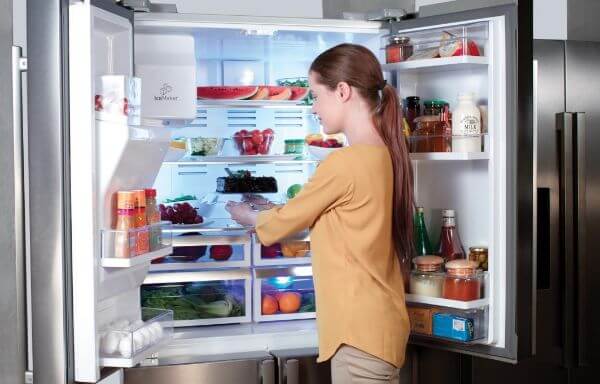Here I’m helping one busy mom get her refrigerator under control.
As we know, it can easily become the most overstuffed part of the household.
I’m going to share some simple tips and tricks designed to keep food fresh and the refrigerator organized.
How to Organize Your Refrigerator Properly
Staple items should all have a permanent place in your fridge. Giving each item a designated place is the first step to keeping your fridge organized.
Liquids can be really tricky because it doesn’t matter what you buy, a bag of milk, a carton of OJ, or even bottles of beer, they all come in really awkwardly shaped containers and take up a ton of real estate.
Milk should actually always be stored in the coldest part of your fridge, which often is at the bottom, keeping in mind the heat always rises.
You want to store your milk as close as possible to the poultry drawer. That’s actually designed to be the coldest part of your fridge.
Keep all your other bottles, like juice and sparkling water next to your milk, since your milk is the only one that has a really rigid temperature requirement.
When it comes to storing soda cans and bottles, I use my fridge’s built-in compartments to store them, or just buy a really inexpensive long, thin container. Super simple and everything has its place.
And now, for my very favorite thing. When it comes to storing wine and liquor in your refrigerator, you can actually use the smallest shelf space and just store them on their sides.
I like to put down just a little piece of rubber shelf liner to stop them from rolling around.
But let’s be serious. The wine in my fridge rarely last that long.
When it comes to storing your eggs, you want to resist storing them in the refrigerator door. This actually experiences the most temperature fluctuations.
You want to store your eggs in the most consistently cold part of your fridge, which is often the center.
You also want to store your egg in their original carton. This carton is designed to prevent your eggs from absorbing other odors and flavors from inside your refrigerator.
The date on rthe carton is actually a sell by date, and the general rule of thumb is that your eggs will last for three weeks after this date, as long as they are refrigerated properly.
So what you want to do is take a marker and jot down the actual best by date, so you’ll know how long your eggs will be fresh.
Most refrigerators today come with a designated meat and cheese drawer that’s actually temperature regulated, so it stays very, very cold.
What I like to do is transfer my meats and cheeses to clear plastic bags, so I can always see what’s in them. You’re more likely to eat them that way.
Keep in mind that most sandwich meats only stay fresh for up to a week after opening, so be sure to jot down a consume by date on them so you and your family know how long they’re safe to eat.
Condiments can get a little crazy in the refrigerator, so what I like to do is designate a specific section for each kind of condiment, and then use a handy label maker to clearly label where things go.
That way, your family has no excuse but to put things back in their place.
BBQ condiments like ketchup, mustard, and barbecue sauce can all stay in the door because they’re all shelf stable.
Takeout packets should be neatly organized in small jars or stacked.
I’ve also created a section for salad dressings and sauces. I recommend downsizing your jars as you use things up, so those larger bottles are not taking up so much room in your fridge.
The rest of the condiments I’ve stored in really inexpensive condiment caddies that are super simple to pull out, so you have easy access to everything in the refrigerator.
When it comes to storing your vegetables, you want to store it like-with-like, so keep things divided.
If you don’t have handy dandy dividers in your refrigerator, no sweat. Simply go out, buy a few inexpensive containers from the dollar store, and just keep things separated. They’ll last a lot longer that way.
You want to leave these plastic produce bags at the grocery store. What I like to do is, as soon as I get home, wash and store all my vegetables in plastic zipper bags. I buy heavy-duty ones so I can reuse them over and over again. This means I will be more likely to use them because all the hard work is already done.
The best way to ensure that all your fresh produce gets consumed is to prep it as soon as you’re home from the grocery store.
So wash and chop all your fruits and vegetables, store them in glass containers, and then be sure to put them in the body of the fridge at eye level with your kids, that way they’ll be the first thing they reach for.
I also invested in some square and rectangular containers over round ones because they really maximize real estate in the refrigerator.
But the real secret to keeping this family’s fridge organized is hidden in the pantry. I’ve actually created an incredible DIY organizer inside their pantry door using some vintage tins and containers and some adhesive tape.
What I’ve included is a shopping list, some sticky notes, some extra zipper bags, some markers, and a secret place to stash their label maker.
And once all your staples have a place, you can actually accommodate for any number of events, like a birthday party, a holiday feast, or even a big night in with friends and family.
And there you have it, I got this family’s fridge more organized and efficient.

